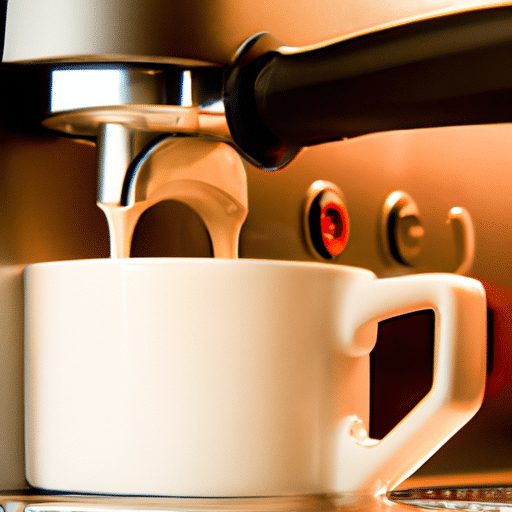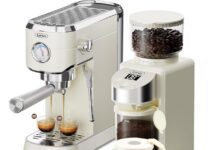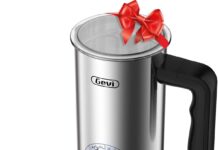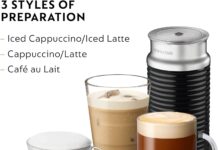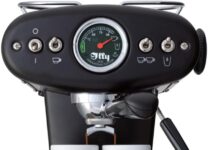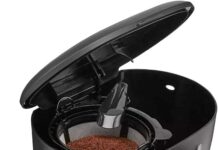Imagine waking up in the morning, groggy and in desperate need of a cup of joe, only to find your beloved coffee maker leaking all over your countertop. Frustration sets in as you ponder the complexities of repairing it. But fear not, because we’re here to guide you through the steps of fixing a leaking coffee maker. From identifying the source of the leak to troubleshooting common issues, we’ll provide you with the knowledge and confidence to restore your trusty caffeine companion back to its leak-free glory. So grab a fresh brew and let’s get to work!
Finding the Source of the Leak
Inspecting the Water Reservoir
When attempting to fix a leaking coffee maker, it is essential to first identify the source of the leak. Often, the water reservoir is the culprit. Check the reservoir for any cracks or damage that could be causing the leakage. If there are any visible issues, it may be necessary to replace the reservoir.
Checking the Drip Tray
The drip tray is another common area where leaks can occur. This tray collects any excess water or coffee that may overflow during the brewing process. Make sure the drip tray is properly aligned and securely in place. If the tray is cracked or damaged, it should be replaced to prevent further leaks.
Examining the Brew Basket
Next, inspect the brew basket. This is the component that holds the coffee grounds during the brewing process. Check for any cracks or loose parts that could be leading to the leak. Additionally, ensure that the brew basket is properly lined up and inserted into the coffee maker. If there are any issues, it may be necessary to repair or replace the brew basket.
Inspecting the Carafe and Lid
A leaking coffee maker can also be caused by a faulty carafe or lid. Carefully examine the carafe for any cracks or damage. Check that the lid is intact and fits securely onto the carafe. If there are any issues with the carafe or lid, it is recommended to replace them to resolve the leakage problem.
Examining the Water Tank
Lastly, check the water tank for any cracks or damage. The water tank is responsible for holding the water that is used in the brewing process. If there are any visible problems with the tank, it may be necessary to replace it. Ensure that the water tank is properly aligned and securely attached to the coffee maker.
Fixing the Leaking Coffee Maker
Checking and Replacing the Gasket
One common cause of coffee maker leaks is a worn-out or damaged gasket. The gasket acts as a seal between different components of the coffee maker, preventing water from escaping. Check the gasket for any signs of wear or damage. If necessary, replace the gasket with a new one to ensure a proper seal and stop the leakage.
Cleaning or Replacing the Keurig Seal
For Keurig coffee makers, the seal may be another potential source of leaks. Over time, the seal can accumulate debris and coffee residue, compromising its effectiveness. Clean the seal thoroughly using a soft cloth or sponge. If the seal is damaged or worn, it should be replaced with a new one to prevent leaks.
Cleaning the Coffee Maker
Regular cleaning is crucial not only for the taste of your coffee but also for preventing leaks. Build-up of minerals, coffee residue, and mold can lead to blockages or damage to various components of the coffee maker. Clean the interior and exterior of the machine regularly using appropriate cleaning solutions or vinegar. Pay attention to the brew basket, water tank, and any other removable parts.
Checking the Water Inlet Valve
The water inlet valve controls the flow of water into the coffee maker. A faulty or malfunctioning valve can result in leaks. Inspect the valve for any signs of damage or blockages. If necessary, clean the valve using a soft brush and water. In more severe cases, the valve may need to be replaced by contacting the manufacturer or a professional repair service.
Adjusting the Brewing Temperature
An incorrect brewing temperature can sometimes cause a coffee maker to leak. If the water temperature is too high, it can lead to excessive pressure and subsequent leaking. Consult the user manual for your coffee maker model and adjust the brewing temperature if it is within your control. Some coffee makers allow users to select their desired temperature settings, which can help prevent leaks.
Preventive Measures to Avoid Leaks
Regular Cleaning and Maintenance
Prevention is always better than cure when it comes to coffee maker leaks. Regularly clean your coffee maker to remove any build-up of minerals, coffee residue, or mold. Follow proper cleaning procedures recommended by the manufacturer to ensure that your machine remains in good working condition. Regular maintenance will not only prolong the lifespan of your coffee maker but also reduce the likelihood of leaks occurring.
Using Proper Ground Coffee
The type of ground coffee you use in your coffee maker can also impact its performance and the likelihood of leaks. Ensure that you are using the appropriate grind size for your coffee maker. Using an incorrect grind size can lead to blockages, forcing the machine to work harder, potentially resulting in leaks. Follow the guidelines provided by the coffee maker manufacturer or consult a coffee expert for recommendations.
Checking the Water Level
Monitoring the water level in your coffee maker is essential to avoid leaks. Overfilling the water tank can cause excess water to overflow and leak out of the machine. Make sure to fill the water tank only up to the recommended level indicated by the manufacturer. By keeping an eye on the water level, you can prevent unnecessary leaks and ensure smooth operation of your coffee maker.
Avoid Overfilling the Coffee Maker
Similar to checking the water level, avoid overfilling the coffee maker with coffee grounds. Overstuffing the brew basket can lead to overflows and cause leaks. Use the appropriate amount of coffee grounds for your desired strength, following the recommended measurements for your specific coffee maker. This will not only prevent leaks but also ensure the best taste and quality in your brewed coffee.
Avoiding Excessive Steam
Excessive steam generated during the brewing process can contribute to leaks in some coffee makers. To minimize steam-related leaks, ensure that the carafe or lid is tightly secured during brewing. If water is escaping due to excessive steam, adjust the brewing temperature or consult the manufacturer’s guidelines for reducing steam output. By controlling the amount of steam, you can prevent leaks and enjoy a hassle-free coffee brewing experience.
Contacting Customer Support
Consulting the User Manual
If you have followed the above steps and are still experiencing leaks with your coffee maker, it may be time to consult the user manual. Different coffee maker models and brands may have specific troubleshooting steps and support information outlined in the manual. Review the manual thoroughly and follow any guidelines provided by the manufacturer to address the issue effectively.
Reaching out to the Manufacturer
If you are unable to resolve the leaking issue on your own, contacting the manufacturer directly can be a helpful next step. Look for the manufacturer’s contact information either on their website or in the user manual provided with your coffee maker. Reach out to their customer support team, explain the problem you are facing, and inquire about potential solutions or warranty coverage if applicable. The manufacturer’s support team will have the expertise to guide you towards a resolution.
Seeking Professional Help
In some cases, resolving a leaking coffee maker may require the assistance of a professional repair service. If your coffee maker is still under warranty, contact the manufacturer’s authorized service center for repairs. If the warranty has expired or you prefer to seek professional help independently, look for reputable appliance repair companies in your area. These experts can diagnose the issue accurately and provide repairs or recommendations accordingly.
Conclusion
Fixing a leaking coffee maker can be a straightforward task if you follow the right steps and conduct a thorough inspection. Start by identifying the source of the leak, which could be the water reservoir, drip tray, brew basket, carafe, or water tank. Once you have located the problem, you can move on to the appropriate fix, whether it involves checking and replacing gaskets, cleaning or replacing seals, adjusting brewing temperature, or contacting customer support. By practicing preventive measures such as regular cleaning, using proper ground coffee, and avoiding overfilling, you can minimize the chances of leaks occurring in the first place. Remember to consult the user manual, reach out to the manufacturer, or seek professional help if needed. With the right approach and maintenance, you can enjoy a leak-free coffee maker and savor every sip of your perfectly brewed coffee.


